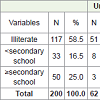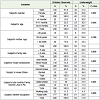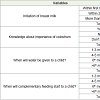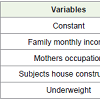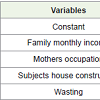Research Article
Maternal Formal Education in Association with Nutritional Status of Children (Less-than Two Years)
Ijaz ul Haq1,2*, Humaira Wasila1, Nawsherwan1, Abbas Khan1, Kaur Chawla R1, Muhammad Imtiaz3 Imran Amad4, Majid Ali5 and Falak Zeb1
1Department of Human Nutrition, The University of Agriculture Peshawar, Pakistan
2Department of Nutrition and food Hygiene, School of Public Health, Nanjing Medical University, Nanjing, Jiangsu, China
3Department of Sociology, University of Peshawar, Pakistan
4Department of Horticulture, The University of Agriculture, Peshawar, Pakistan
5Institute of management Studies, University of Peshawar, Pakistan
Corresponding author: Ijaz ul Haq, Department of Nutrition and food Hygiene, School of Public Health, Nanjing Medical University, Nanjing, Jiangsu, China, Tel: 0086187952007; Fax: 82-25-86868499; E-mail:ijaz@njmu. edu.cn
Citation: ul Haq I, Wasila H, Nawsherwan, Khan A, Chawla KR, et al. Maternal Formal Education in Association with Nutritional Status of Children (Less-than Two Years). Indian J Nutri. 2017;4(2): 162.
Copyright © 2017 ul Haq I, et al. This is an open access article distributed under the Creative Commons Attribution License, which permits unrestricted use, distribution, and reproduction in any medium, provided the original work is properly cited.
Indian Journal of Nutrition | ISSN: 2395-2326 | Volume: 4, Issue: 2
Submission:08/05/2017; Accepted: 22/05/2017; Published: 31/05/2017
Abstract
Background: Child undernutrition is a serious public health problem in children of less than two years. It has been linked with different factors.
Methods: A cross-sectional study was conducted to evaluate the association of maternal formal education with the nutritional status of children. A total of 200 children (aged ≤ 2 years) and their mothers were selected for this study. ENA (Emergency nutrition assessment) and SPSS (version 16.0) software’s were used for analysis.
Results: Results showed that majority (58.5%) of mothers were illiterate. The prevalence of underweight, stunting and wasted children in the study was 31%, 59% and 17.5% respectively. Prevalence of malnutrition in educated mothers was less as compare to illiterate. By χ2 test maternal formal education was significantly associated (p<0.05) with underweight and wasting. There was also a significant association (p<0.05) of family’s total monthly income and mother’s occupation with underweight and wasting. Through linear regression model, after confounding other variables maternal formal education was significantly associated with underweight and wasting.
Conclusion: Maternal formal education is having very importance and influence on maternal nutritional knowledge and child nutritional status. It is recommended that government should have to initiate and monitor nutrition awareness programs in different sectors.
Keywords:
Undernutrition; Underweight; Stunting; Wasting; Maternal formal education
Introduction
Undernutrition, an important public health problem is the outcome of insufficient food intake and repeated infectious diseases, which includes being underweight, stunted, wasted and deficient in vitamins and minerals [1]. Children are considered as underweight, stunted and wasted whose Weight for Age (W/A), Weight for Height (W/H) and Height for Age (H/A) are below 2 standard deviationfrom the median of reference population [2].
Child malnutrition, low education and high infant mortality are the most eloquent social problems of developing countries and among them child malnutrition is considered a significant risk factor for poor health and mortality [3]. Across the world, each year more than ten million children of age less than five years died from preventable and treatable diseases in which half of death occur because of malnutrition [4]. In South Asia, malnutrition is considered the most prevalent public health issue in children aged less than five years [5]. More than 50% South Asian children are malnourished [6]. Also Pakistan is the second highest infant and child mortality country in South Asia and in 2005 mortality rate in under five years children has been showed as 101 per 1000 live births [7]. As per the National Health Survey of Pakistan, one out of every three children is malnourished, less than five years of age children 43.7% were stunted, 31.5% were underweight and 15.1% were wasted [8].
The role of mothers is important in providing care in early childhood. Maternal education is one of the key factors responsible for improvement of child health levels and plays a significant role in child cognitive development and growth [9]. In division of labor in a family, child care is the larger responsibility which lies on shoulders of mothers [10]. Educated mothers have more access to information, implement good health practices and take parts in solving family health issues [11]. According to the Pakistan National Nutritional Survey 41% of mothers are educated and have lower percentage of malnourished children [8].
Malnutrition in Pakistan currently threatens maternal and child survival, especially in underdeveloped and poor areas. Keeping in view the importance of maternal formal education and maternal nutritional knowledge the current study conducted in the rural area of District Swat to evaluate the association between maternal formal educations with the nutritional status of children of less than 2 years. To our best knowledge this is the first study of finding association of maternal formal education in less than two years of children in rural areas.
Material and Methods
Ethical consideration
Approval for this study was obtained from the Chairman, Department of Human Nutrition, the University of Agriculture Peshawar, Peoples Primary Health Care (PPHI) and District health officer (DHO) Swat.
Study population and Inclusion/Exclusion criteria
A convenient sample of 200 children (<2 years) and their consenting mothers attended Basic Health Units of Swat Pakistan were selected for this cross-sectional study and in depth interviewed from May-August 2014.
Healthy or with mild acute health problems children were included and chronically ill children and children of non-consenting, widows and divorced parents were excluded from the study.
Data collection
A pretested questionnaire was used to record data regarding socio-demographic variables, child anthropometry, child health and maternal nutritional knowledge.
For taking anthropometric data, pediatric scale was used for measuring child weights and reading was recorded in kilograms nearest to 0.1 kg following WHO standard protocols. And length board was used for measuring children’s length and data was recorded in centimeters nearest to 0.1 cm.
Statistical analysis
SPSS 16.0 and ENA (Emergency Nutrition Assessment) was used to analyze the data. Descriptive statistics like frequency and percentage was also used to see the data distribution and to check the data for errors. Pearson’s Chi square test was used to find association between different variables. Linear regression model was applied for adjustment of variables. p<0.05 was considered statistically significant.
Results
Association between mother’s education and child malnutrition
The association between subject’s mother education and malnutrition i.e. underweight, stunting and wasting and their frequencies and percentages are given in Table 1. The mean and SD of weight for age z sore, height for age z sore and weight for height z sore of children were 13.2±6.2, -1.4±1.3, -2.2±1.1 and -0.3±1.5 respectively. Mother’s educational level was categorized as illiterate, less than secondary and more than secondary school. The table indicates that majority (58.5%) of mothers were illiterate having high prevalence rate of underweight, stunted and wasted 23.9% children. A significant (p<0.05) relationship was found between mothers formal education and underweight and wasting while stunting and maternal education were non-significantly (p>0.05) associated.
Association between child malnutrition and demographic and socioeconomic variable
The total number, percentage and statistical association of child malnutrition with demographic variable have been shown in Table 2. Among children 51% were male and 49% were female. Most of the mothers were between ages 20-30 years. Majority of families belongs to middle class. Gender was found to be significantly (p<0.05) related with stunting. There was no significant (p>0.05) difference of subjects age, subjects mothers age, family size and subjects house status with underweight, stunting and wasting. Family monthly income, mothers occupational status and type house constructed had significant (p<0.05) association with underweight and wasting while no significant association with stunting.
Effect of maternal formal education on maternal nutritional knowledge
Table 3 shows the effect of maternal formal education on maternal nutritional knowledge. The data regarding 58.5% respondents with no formal education (illiterate) had low maternal nutritional knowledge. However, respondents who were having high education had more nutritional knowledge about their children. 94% of highly educated mothers have knowledge to initiate breast milk in first hour, 70% knows about importance of colostrum and 96% knows correctly about starting complementary food to their children.
Results of linear regression between maternal formal education and other variables
The effects of significant variables were adjusted to find the effectof maternal formal education with underweight in Table 4. It was found by linear regression model that maternal formal education has significant association with underweight.
Similarly by adjusting other significant variables in Table 5 it was found that maternal education has also a significant association with wasting.
Discussion
Child malnutrition is one of the big health problems of Pakistan. Different factors are associated with this problem. Current study was conducted to find association of maternal formal education with child malnutrition. Child malnutrition was assessed on the basis of WAZ, HAZ and WHZ with the help of emergency nutrition assessment software. The prevalence of underweight, stunting and wasting was found 31%, 59% and 17.5% respectively which are like similar to the results of Pakistan National Nutrition Survey (2011), where the prevalence of underweight was 32%, stunting 44% and wasting 15% [8]. However, formal education of mothers had significant role in the prevalence of child malnutrition [4]. According to a study maternal education had significant association with underweight but a non significant association with stunting and wasting which were in line with our study in terms of underweight and stunting but association of mothers’ education with wasting was in contrast [12]. Several studies from developing countries showed that higher education of mothers leads to better child physical growth in infancy and early childhood [13]. Furthermore one of the research groups mentioned that mother’s education was responsible for lower weight for age and height for age of children [14].
In our study stunting was found more in boys as compare to girls. The results of two studies revealed that the prevalence of stunting was more in males as compare to girl [15,16]. Our study was parallel with another study; they reported that the prevalence of underweight and wasting was high in age group 6-11 months’ children as compare to age group 12-23 months [17]. In our study the prevalence of underweight, stunting and wasting was high in male child as compare to girls which was parallel with the study a study it was reported that in early infancy male has high prevalence rate (percentage) of underweight, stunting and wasting than girls [18]. The prevalence of underweight, stunting and wasting was high in big families as compare to small families. A study also revealed similar results in terms of wasting and stunting that joint families had more prevalence of wasting and stunting but underweight prevalence was more in nuclear families [19]. Family monthly income has also an influence over child nutritional status. Our study have also same results with another study, in which it was reported that the higher socioeconomic class had less wasted and underweight children than lower socioeconomic class while stunting was observed in both higher and lower socioeconomic classes and there was no significant association between economic classes and nutritional status. Also working women participate in income generating activities to improve their children nutritional status as well as economy of home [19]. In our study working women has low prevalence rate of malnutrition as compare to house wives because working ladies have more schooling and they can do better jobs. Same to our report two researchers found that working mothers earn more money and they may use it for the better health and nutrition of their children [16].
In our current study we also assessed maternal nutritional knowledge and associate it with maternal formal education. In our study educated mothers were having tendency to initiate breast milk within first hour. In one of a study by some researchers it was shown that maternal education and breast milk initiation were significantly associated with each other and high educated mothers were more like to initiate breast milk within first hour of birth, which coincide with our study [20]. Colostrum is very important for new born. Educated mothers in our study know more about importance of colostrum. Same results was shown by a group of scientist which states that giving of colostrum to babies is more common in educated women and there is a strong association between them [21]. Our results showed that mothers with higher education had knowledge to exclusive breast feed their children while most illiterate or less educated mothers had low knowledge about proper exclusive breast feeding (to start water and complementary feeding within 6 months). In line to our findings a report states that in developed countries longer duration and more exclusive breast feeding is associated with higher mother’s education [13].
Conclusion
In summary, the current study provides sufficient data regarding maternal formal education and its association with child malnutrition in rural area. Maternal formal education has huge impact on child nutritional status. Majority of mothers are illiterate. The prevalence of malnutrition of malnutrition is high in illiterate mothers. Also the illiterate mothers have low nutritional knowledge as compare to others educational groups. Maternal formal education is positively associated with underweight and wasting. The above findings enlighten the importance of formal education as well as nutritional education in females especially mothers. Therefore it is the call of the hour to focus on female education and female empowerment. Government should have to initiate nutrition awareness programs in formal as well as in informal institution.
Acknowledgement
I am thankful to all participant “mothers†in the study, Government health department staff and Center of Rural Development’s staff for their support.
References
- UNICEF (2006) Nutrition, survival and development. Progress for Children.
- WHO (2007) WHO child growth standards: Head circumference-for-age, arm circumference-for-age, triceps skinfold-for-age and subscapular skinfold-for-age: Methods and development. pp. 1-217.
- Cheah WL, Muda WA, Zamh ZH (2010) A structural equation model of the determinants of malnutrition among children in rural Kelantan, Malaysia. Rural Remo Health 10: 1248.
- Hien NN, Kam S (2008) Nutritional status and the characteristics related to malnutrition in children under five years of age in Nghean, Vietnam. J Prev Med Public Health 41: 232-240.
- Gopalan S (2000) Malnutrition: Causes, consequences, and solutions. Nutrition 16: 556-558.
- Bhutta ZA (2004) Maternal and child health in Pakistan: challenges and opportunities. Oxford University Press, pp. 257.
- Brown N (2008) Perinatal and newborn care in South Asia: Priorities and action. Arch Dis Child 93: 358.
- UNICEF (2011) Government of Pakistan: National nutrition survey. Agha Khan University, Pakistan.
- Monazza A, Kingdon GG (2012) Parental education and child health-understanding the pathways of impact in Pakistan. World Dev 40: 2014-2032.
- Grossman M (2006) Education and nonmarket outcomes. In: Hanushek EA, Welch F (Eds), Handbook of the economics of education, 1: 577-633.
- Ali S, Chaudry T, Naqvi QA (2011) Effect of maternal literacy on child health: Myth or reality. Ann Pak Inst Med Sci 7: 100-103.
- Ali SS, Karim N, Billoo AG, Haider SS (2005) Association of literacy of mothers with malnutrition among children under three years of age in rural area of district Malir, Karachi. J Pak Med Assoc 55: 550-553.
- Wachs TD (2008) Multiple influences on children's nutritional deficiencies: A systems perspective. Physiol Behav 94: 48-60.
- Sakisaka K, Wakai S, Kuroiwa C, Cuadra Flores L, Kai I, et al. (2006) Nutritional status and associated factors in children aged 0-23 months in Granada, Nicaragua. J Public Health 120: 400-411.
- Semba RD, de Pee S, Sun K, Sari M, Akhter N, et al. (2008) Effect of parental formal education on risk of child stunting in Indonesia and Bangladesh: A cross-sectional study. Lancet 371: 322-328.
- Brhane G, Regassa N (2014) Nutritional status of children under five years of age in Shire Indaselassie, North Ethiopia: Examining the prevalence and risk factors. Kontakt 16: e161-e170.
- Arif GM, Nazir S, Satti MN, Farooq S (2012) Child malnutrition in Pakistan: Trends and determinants. Pakistan Institute of Development Economics, Islamabad.
- Adel ET, Marie-Françoise RC, Salaheddin MM, Najeeb E, Ahmed AM, et al. (2008) Nutritional status of under-five children in Libya; A national population-based survey. Libyan J Med 3: 13-19.
- Nayak RK, Walvekar PR, Mallapur MD (2014) Determinants of nutritional status of under-five children-A cross sectional study. Ann Community Health 2: 26-30.
- Adhikari M, Khanal V, Karkee R, Gavidia T (2014) Factors associated with early initiation of breastfeeding among Nepalese mothers: Further analysis of Nepal Demographic and Health Survey, 2011. Int Breastfeed J 9: 21.
- Okolo SN, Adewunmi YB, Okonji MC (1999) Current breastfeeding knowledge, attitude and practices of mothers in five rural communities in the Savannah region of Nigeria. J Trop Pediatr 45: 323-326.

